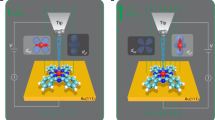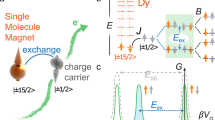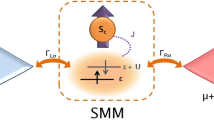Abstract
Phenomena that are highly sensitive to magnetic fields can be exploited in sensors and non-volatile memories1. The scaling of such phenomena down to the single-molecule level2,3 may enable novel spintronic devices4. Here, we report magnetoresistance in a single-molecule junction arising from negative differential resistance that shifts in a magnetic field at a rate two orders of magnitude larger than Zeeman shifts. This sensitivity to the magnetic field produces two voltage-tunable forms of magnetoresistance, which can be selected via the applied bias. The negative differential resistance is caused by transient charging5,6,7 of an iron phthalocyanine (FePc) molecule on a single layer of copper nitride (Cu2N) on a Cu(001) surface, and occurs at voltages corresponding to the alignment of sharp resonances in the filled and empty molecular states with the Cu(001) Fermi energy. An asymmetric voltage-divider effect enhances the apparent voltage shift of the negative differential resistance with magnetic field, which inherently is on the scale of the Zeeman energy8. These results illustrate the impact that asymmetric coupling to metallic electrodes can have on transport through molecules, and highlight how this coupling can be used to develop molecular spintronic applications.
This is a preview of subscription content, access via your institution
Access options
Subscribe to this journal
Receive 12 print issues and online access
$259.00 per year
only $21.58 per issue
Buy this article
- Purchase on Springer Link
- Instant access to full article PDF
Prices may be subject to local taxes which are calculated during checkout





Similar content being viewed by others
References
Wolf, S. A. et al. Spintronics: a spin-based electronics vision for the future. Science 294, 1488–1494 (2001).
Schmaus, S. et al. Giant magnetoresistance through a single molecule. Nature Nanotech. 6, 185–189 (2011).
Kawahara, S. L. et al. Large magnetoresistance through a single molecule due to a spin-split hybridized orbital. Nano Lett. 12, 4558–4563 (2012).
Bogani, L. & Wernsdorfer, W. Molecular spintronics using single-molecule magnets. Nature Mater. 7, 179–186 (2008).
Chen, J., Reed, M. A., Rawlett, A. M. & Tour, J. M. Large on–off ratios and negative differential resistance in a molecular electronic device. Science 286, 1550–1552 (1999).
Wu, S. W., Nazin, G. V., Chen, X., Qiu, X. H. & Ho, W. Control of relative tunneling rates in single molecule bipolar electron transport. Phys. Rev. Lett. 93, 236802 (2004).
Fernández-Torrente, I., Kreikemeyer-Lorenzo, D., Stróżecka, A., Franke, K. J. & Pascual, J. I. Gating the charge state of single molecules by local electric fields. Phys. Rev. Lett. 108, 036801 (2012).
Ham, U. & Ho, W. Spin splitting unconstrained by electron pairing: the spin-vibronic states. Phys. Rev. Lett. 108, 106803 (2012).
Binasch, G., Grunberg, P., Saurenbach, F. & Zinn, W. Enhanced magnetoresistance in layered magnetic structures with antiferromagnetic interlayer exchange. Phys. Rev. B 39, 4828–4830 (1989).
Moodera, J. S., Kinder, L. R., Wong, T. M. & Meservey, R. Large magnetoresistance at room temperature in ferromagnetic thin film tunnel junctions. Phys. Rev. Lett. 74, 3273–3276 (1995).
Urdampilleta, M., Klyatskaya, S., Cleuziou, J.-P., Ruben, M. & Wernsdorfer, W. Supramolecular spin valves. Nature Mater. 10, 502–506 (2011).
Lyo, I. W. & Avouris, P. Negative differential resistance on the atomic scale: implications for atomic scale devices. Science 245, 1369–1371 (1989).
Chen, L. et al. Mechanism for negative differential resistance in molecular electronic devices: local orbital symmetry matching. Phys. Rev. Lett. 99, 146803 (2007).
Xue, Y. Q. et al. Negative differential resistance in the scanning-tunneling spectroscopy of organic molecules. Phys. Rev. B 59, R7852–7855 (1999).
Wang, B. et al. Effects of discrete energy levels on single-electron tunneling in coupled metal particles. Appl. Phys. Lett. 82, 3767–3769 (2003).
Gaudioso, J., Lauhon, L. J. & Ho, W. Vibrationally mediated negative differential resistance in a single molecule. Phys. Rev. Lett. 85, 1918–1921 (2000).
Grobis, M., Wachowiak, A., Yamachika, R. & Crommie, M. F. Tuning negative differential resistance in a molecular film. Appl. Phys. Lett. 86, 204102 (2005).
Tu, X., Mikaelian, G. & Ho, W. Controlling single-molecule negative differential resistance in a double-barrier tunnel junction. Phys. Rev. Lett. 100, 126807 (2008).
Heinrich, B., Rastei, M., Choi, D. J., Frederiksen, T. & Limot, L. Engineering negative differential conductance with the Cu(111) surface state. Phys. Rev. Lett. 107, 246801 (2011).
Brown, E. R. et al. Oscillations up to 712 GHz in InAs/AlSb resonant-tunneling diodes. Appl. Phys. Lett. 58, 2291–2293 (1991).
Ozbay, E. & Bloom, D. M. 110-GHz monolithic resonant-tunneling-diode trigger circuit. IEEE Electron. Dev. Lett. 12, 480–482 (1991).
Hirjibehedin, C. F., Lutz, C. P. & Heinrich, A. J. Spin coupling in engineered atomic structures. Science 312, 1021–1024 (2006).
Scarfato, A. et al. Scanning tunneling microscope study of iron(II) phthalocyanine growth on metals and insulating surfaces. Surf. Sci. 602, 677–683 (2008).
Mugarza, A. et al. Orbital specific chirality and homochiral self-assembly of achiral molecules induced by charge transfer and spontaneous symmetry breaking. Phys. Rev. Lett. 105, 115702 (2010).
Minamitani, E. et al. Symmetry-driven novel Kondo effect in a molecule. Phys. Rev. Lett. 109, 086602 (2012).
Tsukahara, N. et al. Adsorption-induced switching of magnetic anisotropy in a single iron(II) phthalocyanine molecule on an oxidized Cu(110) surface. Phys. Rev. Lett. 102, 167203 (2009).
Mizuta, H. & Tanoue, T. The Physics and Applications of Resonant Tunnelling Diodes (Cambridge Univ. Press, 1995).
Mikaelian, G., Ogawa, N., Tu, X. W. & Ho, W. Atomic scale control of single molecule charging. J. Chem. Phys. 124, 131101 (2006).
Mugarza, A. et al. Spin coupling and relaxation inside molecule metal contacts. Nature Commun. 2, 490 (2011).
Huang, J. et al. Iron–phthalocyanine molecular junction with high spin filter efficiency and negative differential resistance. J. Chem. Phys. 136, 064707 (2012).
Kahle, S. et al. The quantum magnetism of individual manganese-12-acetate molecular magnets anchored at surfaces. Nano Lett. 12, 518–521 (2012).
Repp, J., Meyer, G., Stojkovic, S., Gourdon, A. & Joachim, C. Molecules on insulating films: scanning-tunneling microscopy imaging of individual molecular orbitals. Phys. Rev. Lett. 94, 026803 (2005).
Chen, X. et al. Probing superexchange interaction in molecular magnets by spin-flip spectroscopy and microscopy. Phys. Rev. Lett. 101, 197208 (2008).
Acknowledgements
The authors thank G. Aeppli, V. Crespi, J. Elzerman, J. Fernández-Rossier, M. Hybertsen, P. Littlewood, S. Loth, C. Mathieu, M. Ternes and J. van Slageren for stimulating discussions. B.W., F.E.H., H.P., A.J.F. and C.F.H. acknowledge financial support from the Engineering and Physical Sciences Research Council (EPSRC) (EP/H002367/1 and EP/D063604/1) and the Leverhulme Trust (RPG-2012-754). M.P. is grateful for support from European Union project ARTIST (reference 243421) and allocations of computer resources at the high-performance computing facility HECToR through the Materials Chemistry Consortium funded by the EPSRC (EP/L000202/1) and at the Parallell Dator Centrum through the Swedish National Infrastructure for Computing.
Author information
Authors and Affiliations
Contributions
F.E.H. and C.F.H. conceived of the experiments. B.W., F.E.H. and H.P. performed the experiments and analysed the results. J.S. and M.P. performed the DFT calculations. All authors discussed the results and contributed to writing the paper.
Corresponding author
Ethics declarations
Competing interests
The authors declare no competing financial interests.
Supplementary information
Supplementary information
Supplementary Information (PDF 459 kb)
Rights and permissions
About this article
Cite this article
Warner, B., El Hallak, F., Prüser, H. et al. Tunable magnetoresistance in an asymmetrically coupled single-molecule junction. Nature Nanotech 10, 259–263 (2015). https://doi.org/10.1038/nnano.2014.326
Received:
Accepted:
Published:
Issue Date:
DOI: https://doi.org/10.1038/nnano.2014.326
This article is cited by
-
Easy axis anisotropy creating high contrast magnetic zones on magnetic tunnel junctions based molecular spintronics devices (MTJMSD)
Scientific Reports (2022)
-
Concepts in the design and engineering of single-molecule electronic devices
Nature Reviews Physics (2019)
-
Tunable giant magnetoresistance in a single-molecule junction
Nature Communications (2019)
-
Sub-molecular modulation of a 4f driven Kondo resonance by surface-induced asymmetry
Nature Communications (2016)



